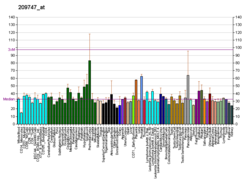TGF bêta 3
gène de l'espèce Homo sapiens
Le TGF bêta 3 est l'un des trois facteur de croissance transformant (TGF de l'anglais transforming growth factor) de type bêta. Son gène est le TGFB3 situé sur le chromosome 14 humain.
En médecine modifier
La mutation du gène peut entraîner un syndrome malformatif associant une masse musculaire réduite, une petite taille, une arthrogrypose, une hypotonie, une uvule bifide[5] ou des signes apparentés avec un syndrome de Loeys-Dietz[6]. Elle est décrite dans certains cas d'anévrisme ou de dissection aortique[7].
Notes et références modifier
- GRCh38: Ensembl release 89: ENSG00000119699 - Ensembl, May 2017
- GRCm38: Ensembl release 89: ENSMUSG00000021253 - Ensembl, May 2017
- « Publications PubMed pour l'Homme », sur National Center for Biotechnology Information, U.S. National Library of Medicine
- « Publications PubMed pour la Souris », sur National Center for Biotechnology Information, U.S. National Library of Medicine
- (en) Rienhoff Jr. HY, Yeo CY, Morissette R et al. A mutation in TGFB3 associated with a syndrome of low muscle mass, growth retardation, distal arthrogryposis and clinical features overlapping with Marfan and Loeys-Dietz syndrome, Am J Med Genet A, 2013;161A:2040–2046.
- (en) Matyas G, Naef P, Tollens M et al. De novo mutation of the latency-associated peptide domain of TGFB3 in a patient with overgrowth and Loeys-Dietz syndrome features, Am J Med Genet A, 2014;164A:2141–2143.
- (en) Bertoli-Avella AM, Gillis E, Morisaki H et al. Mutations in a TGF-β ligand, TGFB3, cause syndromic aortic aneurysms and dissections, JACC (en), 2015;65:1324–1336.





